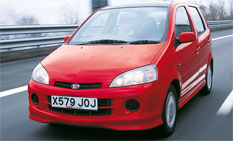Review
Its importers optimistically draw comparisons with more expensive vehicles such as the Volkswagen Polo, Peugeot 206, Fiat Punto and even the Audi A2 and Mercedes-Benz A-class. But as far as the fleet market is concerned it will probably become more appropriately compared with cars such as the Daewoo Matiz, Hyundai Atoz and Toyota Yaris - with which it shares its 1.3-litre engine.
Daihatsu Vehicle Distributors was formed around one year ago when International Motors bought the Daihatsu franchise from Inchcape for £9 million. Over the course of this year, the company expects to consolidate its investment by selling a total of more than 9,000 vehicles, about 3,000 of them YRVs. Next year, it reckons its sales will top 12,000 - 5,000 being YRVs. The new importers have discontinued the Move, Grand Move and Charade and the YRV now becomes the flagship of the current range which also comprises the Cuore, Sirion and Terios. It is predicted by Daihatsu that mainland Europe will account for at least 25% of all YRV sales.
According to Joe McCue, sales director of Daihatsu Vehicle Distributors, the larger fleets will not be a major target for the YRV. 'It will appeal mainly to smaller fleets, user-choosers and driving schools. But of course, we cannot offer the sort of deals to the big operators that companies like Vauxhall can with the Corsa,' he said. The YRV - it stands for 'young recreational vehicle' - retains the short-in-length, tall-in-height proportions of the Move, which provided such generous interior dimensions, yet cleverly disguises these with window shapes and other styling cues which offset the ungainliness this format can prompt.
Light weight, a punchy little engine and fairly slippery aerodynamics contribute to acceptably lively performance, good fuel economy - and, arguably most relevant from the fleet viewpoint, low carbon dioxide emission figures of 145g/km for the manual version and 156g/km for the auto. Initially, three versions are being offered in the UK, although a turbo variant - already on sale in Japan - will be offered late this year or early in 2002. The range starts with the basic £9,495 YRV, which is itself quite well equipped with power-steering, driver and passenger airbags, central locking, electric windows front and rear and height-adjustable driver's seat.
One step up and costing £1,000 more, the Premium gets air-conditioning, ABS with electronic brake force distribution, remote central locking, alloy wheels and rear head restraints. For £1,000 more, at £11,495, fleets can have 'F-Speed' automatic transmission with steering wheel-mounted push-button shift system and a CD player. A fixed glass roof is a £295 option with the Premium and F-Speed variants. All have body-coloured bumpers, door mirrors and door handles.
The YRV is a cleverly-packaged concept, not as versatile as a larger mini-MPV, such as the Renault Scenic, but versatile nonetheless. As well as having a split/fold facility, the rear seats can be slid forward 150mm to provide increased luggage space - a sensible arrangement when small children are the rear seat passengers, less conducive to in-car harmony if long-legged adults are in the back. The overall interior impression is - perhaps surprisingly - quite up-market, with what Daihatsu calls 'dimple-effect' facia and door casings and clear instruments set in an 'aluminium-effect' dashboard panel.
The interior is also deceptively roomy and comfortable. Two six-foot-plus adults can ride comfortably side-by-side in the front without too much clashing of elbows - or even one behind the other, as long as the rear seats are slid to their rearmost position. Daihatsu strongly touts the safety attributes of its new baby. It claims that like its stablemate, the Sirion, its front structure has been designed to deflect the engine and transmission downwards in a frontal impact.
The Sirion also tops the pedestrian-friendly car league with three Euro NCAP stars. Also, in a collision, as well as activating the airbags, the YRV's electronics turn on the interior light, unlock the doors, switch on the hazard warning lights and turn off the fuel-pump. On the often very indifferent roads in and around Milan, during a period of non-stop, torrential rain, the YRV seemed solidly made and generally well put together - although the optional 'panorama' fixed glass roof did deposit a substantial amount of rainwater in my lap when negotiating a tight bend. The ride quality and refinement is good, while handling and grip are totally acceptable.
The validity of the F-Speed transmission is debatable in the context of the YRV. It works in a similar fashion to Alfa Romeo's 'Selespeed' box on the 156 and 147. In the YRV, 'Steershift', via the buttons, is activated or de-activated by a switch on the dashboard. While the system works well enough, I do wonder whether most owners who had paid £1,000 extra for it - plus a CD player - would soon take to just treating it like a normal auto box. Granted, on twisty mountain roads it gives the driver more engine braking but this is supposed to be primarily a 'town car', after all. On sale now, the YRV is an interesting and worthy contender in the Ford Fiesta-sized segment.
















Login to comment
Comments
No comments have been made yet.